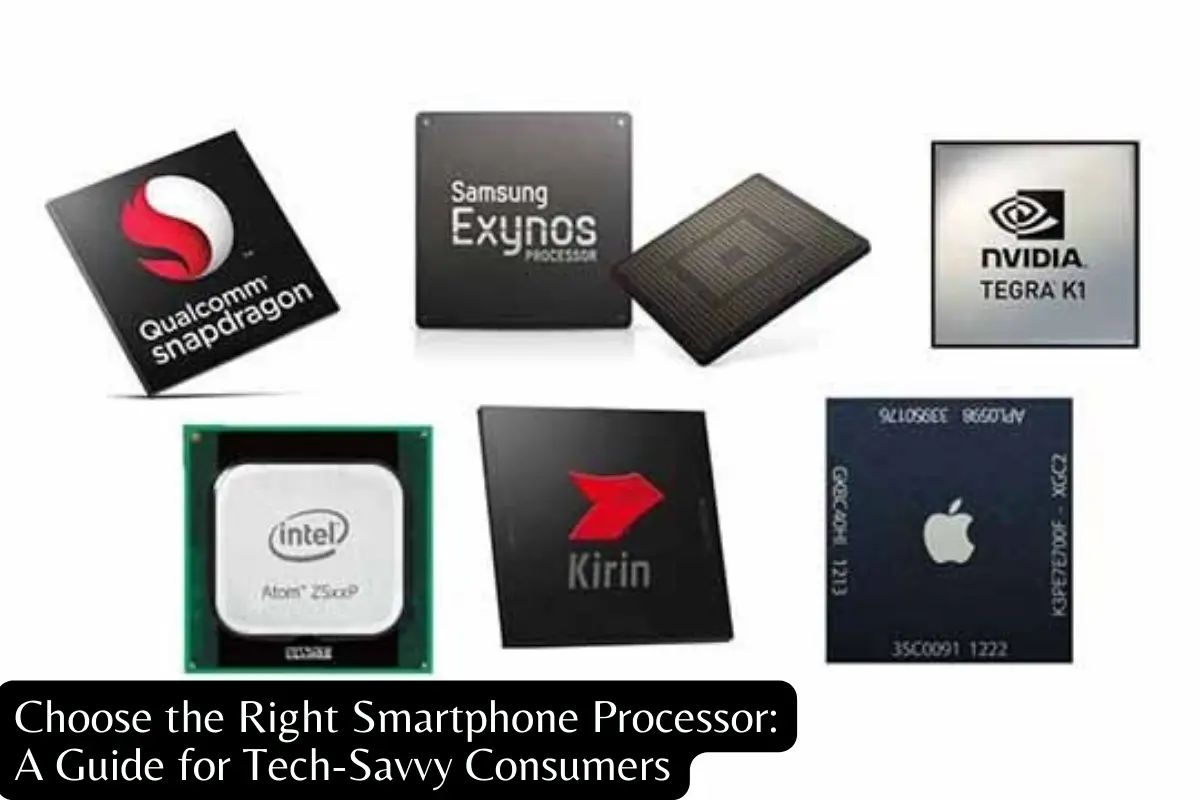Smartphones have become an essential part of our lives, and with the advancements in technology, smartphone processors have also evolved. However, with so many options in the market, it can be challenging to choose the right processor for your smartphone. This guide aims to help tech-savvy consumers make an informed decision when it comes to selecting a smartphone processor.
Types of Processors:
Before we dive into the details, let’s take a look at the different types of processors available in smartphones. The most common types of processors are:
- Qualcomm Snapdragon
- MediaTek Helio
- Samsung Exynos
- Apple A-series
Qualcomm Snapdragon processors are found in most Android smartphones, while MediaTek Helio processors are commonly used in budget smartphones. Samsung uses Exynos processors in its flagship devices, and Apple uses its A-series processors in iPhones.
What are the Processor Cores?
The number of cores in a processor determines how many tasks it can perform simultaneously. There are two types of processors: single-core and multi-core. Single-core processors can only handle one task at a time, while multi-core processors can handle multiple tasks simultaneously.
The majority of modern smartphone processors are multi-core, with two, four, six, eight, or even ten cores. However, more cores do not necessarily mean better performance. In fact, having too many cores can drain your battery faster. A quad-core or an octa-core processor is generally sufficient for most users.
What is the Processor Clock Speed?
Clock speed is the measure of how fast a processor can perform a task. It is measured in GHz (gigahertz), and a higher clock speed means faster processing. However, clock speed is not the only factor that affects the overall performance of a processor. Other factors, such as the number of cores, the processor architecture, and the GPU, also play a crucial role.
What is Processor Architecture?
The processor architecture is the design of the processor, which affects its overall performance. The two most common processor architectures in smartphones are ARM and x86. ARM processors are designed for low power consumption and are commonly used in mobile devices. x86 processors, on the other hand, are commonly used in desktop and laptop computers.
GPU Performance:
The graphics processing unit (GPU) is responsible for rendering images, videos, and animations on your smartphone screen. A powerful GPU can enhance your gaming and multimedia experience. The most commonly used GPUs in smartphones are Adreno (Qualcomm), Mali (ARM), and PowerVR (Apple).
Benchmarks:
Benchmarks are performance tests that can help you compare the performance of different processors. Geekbench, AnTuTu, and GFXBench are popular benchmarking tools for smartphones. However, it is important to note that benchmarks do not always reflect real-world usage scenarios and should be taken with a grain of salt.
Conclusion:
Choose the right smartphone processor can be a daunting task, but by considering the factors mentioned in this guide, you can make an informed decision. Look for a processor that suits your needs and budget. If you are a heavy gamer or a multimedia user, look for a processor with a powerful GPU. If you are a light user, a quad-core or an octa-core processor with a clock speed of 2 GHz or higher should be sufficient. Remember that the processor is just one component of your smartphone, and other factors, such as battery life, camera, and display, should also be taken into consideration.
Difference Between “Qualcomm Snapdragon Vs MediaTek Helio”
| Features | Qualcomm Snapdragon | MediaTek Helio |
|---|---|---|
| Architecture | ARM | ARM |
| Manufacturing Process | 5 nm, 6 nm, 7 nm, 8 nm, 10 nm, 11 nm, 12 nm, 14 nm, 20 nm, 28 nm, 45 nm | 7 nm, 12 nm, 16 nm, 20 nm, 28 nm |
| CPU | Kryo custom cores based on ARM Cortex technology | ARM Cortex cores |
| CPU Cores | Dual-core, quad-core, Hexa-core, octa-core, deca-core | Dual-core, quad-core, hexa-core, octa-core, deca-core |
| CPU Clock Speed | Up to 3.2 GHz | Up to 2.3 GHz |
| GPU | Adreno graphics | Mali graphics |
| AI | Hexagon DSP for on-device AI processing | APU for on-device AI processing |
| Modem | X15, X20, X24, X55, X60 | Cat-4, Cat-6, Cat-7, Cat-10, Cat-12, Cat-13 |
| Camera | Qualcomm Spectra ISP, Up to 192 MP single, up to 64 MP dual | MediaTek Imagiq ISP, Up to 64 MP single, up to 32 MP dual |
| Display | Support for up to 4K resolution and HDR | Support for up to Full HD resolution and HDR |
| Battery Efficiency | Optimized for battery efficiency | Optimized for battery efficiency |
| Quick Charge Technology | Quick Charge 3.0, 4.0, 4+ | Pump Express, Pump Express Plus |
| Thermal Management | Better thermal management compared to MediaTek Helio | Not as good as Qualcomm Snapdragon |
Overall, Qualcomm Snapdragon processors tend to offer better performance and power efficiency compared to MediaTek Helio processors. They also tend to have better thermal management, which helps keep the device cool during heavy usage. However, MediaTek Helio processors are generally more affordable, making them a good option for budget-friendly devices.
Difference Between “Samsung Exynos Vs Apple A-series”
| Feature/Specification | Samsung Exynos | Apple A-series |
|---|---|---|
| Year Introduced | 2010 | 2010 |
| Manufacturing Process | 5nm, 7nm, 10nm, 14nm | 5nm, 7nm, 10nm, 14nm |
| CPU Cores | Octa-core | Hexa-core, Octa-core |
| GPU | Mali | Apple GPU |
| AI Capabilities | Yes | Yes |
| Modem | Exynos Modem | Qualcomm Modem |
| Maximum RAM Capacity | 16GB | 16GB |
| Maximum Display Resolution | WQUXGA (3840×2400) | WQUXGA (3840×2400) |
| Maximum Camera Resolution | 200MP | 12MP (dual-camera) |
| Integrated Security | Samsung Knox | Secure Enclave |
| Wireless Connectivity | Wi-Fi 6E, Bluetooth 5.2 | Wi-Fi 6E, Bluetooth 5.2 |
As you can see from the table, Samsung Exynos and Apple A-series processors are quite similar in terms of the manufacturing process, AI capabilities, and wireless connectivity. However, there are some differences in terms of CPU cores, GPU, modem, maximum camera resolution, and integrated security.
Samsung Exynos processors typically feature octa-core CPUs and Mali GPUs, whereas Apple A-series processors typically feature hexa-core or octa-core CPUs and Apple GPUs. Exynos processors also have their own modems, while Apple A-series processors use Qualcomm modems. Exynos processors have a higher maximum camera resolution than Apple A-series processors, and Samsung Knox provides integrated security features while Apple uses its own Secure Enclave.
Overall, both Samsung Exynos and Apple A-series processors are high-quality options for mobile devices, and which one is better for you will depend on your specific needs and preferences.
Difference Between “Qualcomm Snapdragon Vs Samsung Exynos”
| Features | Qualcomm Snapdragon | Samsung Exynos |
|---|---|---|
| Process technology | 5nm (Snapdragon 8 Series) | 5nm (Exynos 2100) |
| CPU | Octa-core (up to 3.2GHz) | Octa-core (up to 2.9GHz) |
| GPU | Adreno (Snapdragon 8 Series) | Mali (Exynos 2100) |
| Neural processing unit (NPU) | Hexagon (Snapdragon 8 Series) | N/A (Exynos 2100) |
| AI performance | Up to 26 TOPS | N/A (Exynos 2100) |
| Modem | X60 5G (Snapdragon 8 Series) | Exynos Modem 5123 (Exynos 2100) |
| Camera support | Up to 200MP | Up to 200MP |
| Display support | 4K HDR | WQHD+ 144Hz |
| Quick Charge support | Quick Charge 5 | N/A (Exynos 2100) |
| Wireless charging support | Yes | Yes |
As you can see from the table, both Qualcomm Snapdragon and Samsung Exynos are top-of-the-line mobile processors with similar features. The Snapdragon 8 Series and Exynos 2100 both use the same 5nm process technology, which means they are both power-efficient and can deliver high performance.
In terms of CPU and GPU, the Snapdragon 8 Series has an octa-core processor with clock speeds of up to 3.2GHz and Adreno graphics, while the Exynos 2100 also has an octa-core processor with clock speeds of up to 2.9GHz and Mali graphics. Both processors have support for high-resolution cameras, with up to 200MP, and display support for 4K HDR and WQHD+ 144Hz, respectively.
The Snapdragon 8 Series also has a neural processing unit (NPU) in the form of the Hexagon, which is designed specifically for AI tasks. This gives the Snapdragon 8 Series an AI performance of up to 26 TOPS, while the Exynos 2100 does not have an NPU.
In terms of connectivity, the Snapdragon 8 Series has the X60 5G modem, while the Exynos 2100 has the Exynos Modem 5123. Both modems support 5G connectivity, but the Snapdragon 8 Series modem has better support for global 5G networks.
Lastly, the Snapdragon 8 Series supports Quick Charge 5, which is Qualcomm’s latest fast-charging technology, while the Exynos 2100 does not have any quick charge support. Both processors support wireless charging.
Overall, both the Qualcomm Snapdragon and Samsung Exynos processors are great choices for high-performance mobile devices. The choice between the two will depend on individual preferences and specific device requirements.
READ ALSO:
- Samsung Galaxy A24 4G’s Renders In 4 Colors With Full Specs Leaked
- IQOO Z7 5G To Launch In India On March 21 At Under 20,000
- Xiaomi 11 Lite NE 5G MIUI 14 Update Rolling Out In India
- Redmi Note 12 Turbo Has Received China MIIT Certification
- Motorola Moto E13 India Launch Date & Price Have Been Leaked





I loved even more than you will get done right here. The overall look is nice, and the writing is stylish, but there’s something off about the way you write that makes me think that you should be careful what you say next. I will definitely be back again and again if you protect this hike.